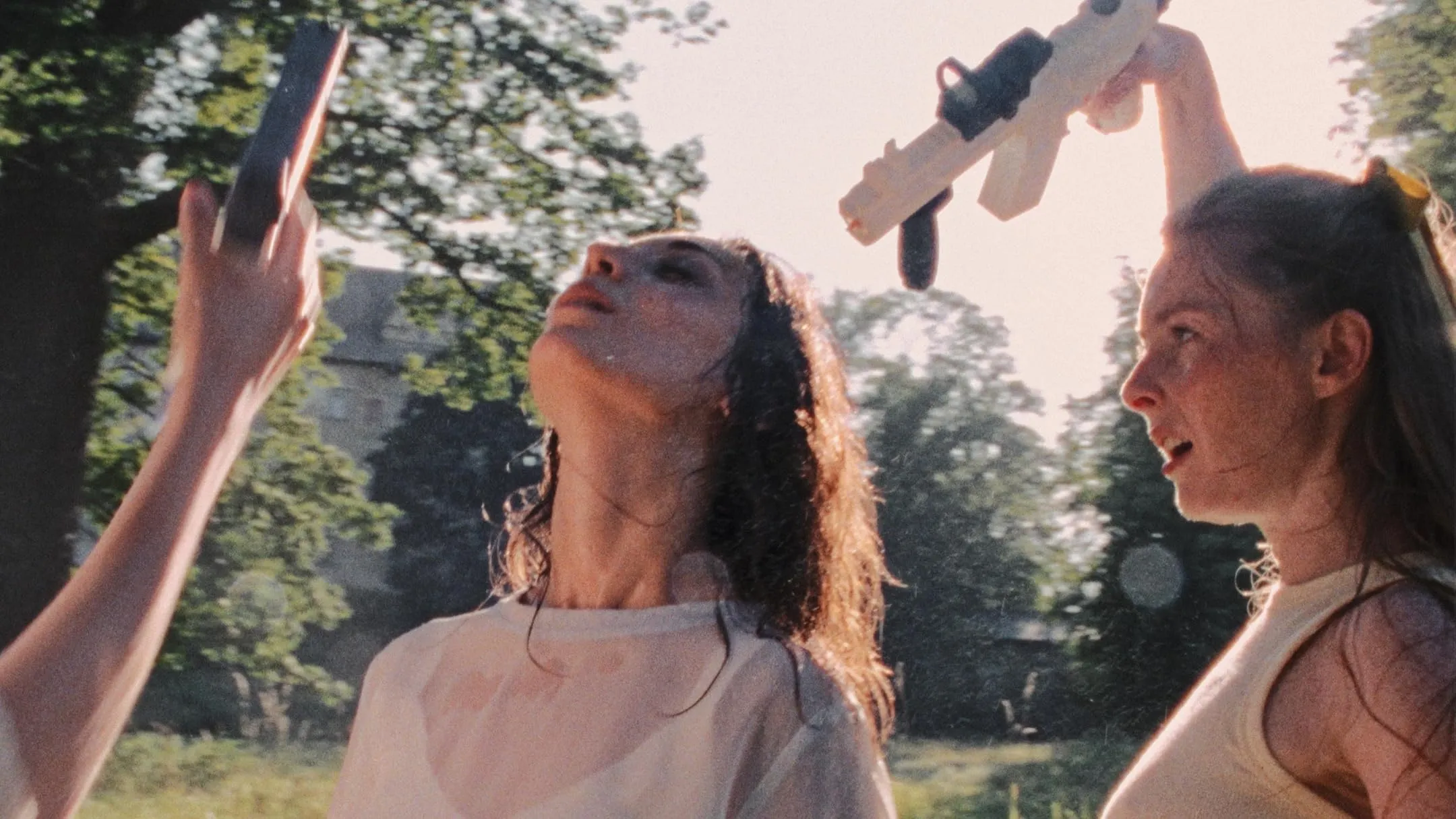Glorious Summer, directed by Helena Ganjalyan and Bartosz Szpak, unfolds over an intimate 88 minutes shot on grain-rich 16 mm stock. Within the sunlit confines of an elegant, palatial estate, three women rise each morning to recite whispered affirmations, their voices woven into an uncanny ritual.
They inhabit a closed world where time seems to stagnate: days spent lounging by a pale stone pool, evenings punctuated only by the mechanical murmur of an unseen steward. Hints of upheaval drift in on distant winds—muffled detonations that contrast sharply with the estate’s tranquil veneer.
The film drifts forward in languid long takes, inviting viewers into a hypnotic loop of serenity and unease. Each frame feels meticulously composed, as though one is peering through a slowly widening lens into a hidden alcove of existence. By withholding conventional plot thrusts, Glorious Summer gently coaxes curiosity to bloom—an invitation to consider what lies beyond the walls without ever forcing its hand.
Visual and Auditory Design
The choice of 16 mm film imbues every shot with a tactile warmth and the subtle grain of nostalgia. Natural sunlight filters through arched windows, casting muted ochres and sun-bleached neutrals across stone corridors.
Each composition balances stillness and depth: static wides that underscore the women’s containment give way to occasional, fluid tracking shots that seem to pry at the edges of their sanctum. Production design draws from Renaissance motifs—ornate columns, frescoed walls, a shallow plunge pool edged in carved marble—while the props remain spare and purposeful, their textures inviting quiet inspection.
Sound becomes an invisible architect of mood. A disembodied feminine voice issues instructions in English, Arabic, Swedish and Italian, its multilingual tone reinforcing both intimacy and distance. Mantras loop in soft echo, punctuated by the low hum of unseen machinery.
Moments of almost unbearable silence settle like dust, allowing ambient sounds—footsteps on stone, water ripple—to resonate. Then, like an unsettled dream, a distant explosion fractures the calm, a reminder of volatility lurking just beyond. As the film progresses, shifts in sonic texture—occasionally sharper, at other times more muted—mirror the gradual tension rising within this closed paradise.
Characters and Performances
At the center stands the de facto leader (Helena Ganjalyan), whose measured gaze and purposeful posture betray an undercurrent of distrust. Her every movement suggests careful calculation, as though she alone senses the fault lines beneath their gilded routine.
Beside her, the confidant (Magdalena Fejdasz-Hanczewska) carries herself with steadfast loyalty. Subtle gestures—a hand placed lightly on a shoulder, a cautious nod—speak volumes about her resolve and quiet endurance. In contrast, the innocent (Daniela Komędera) moves with open curiosity: her eyes brighten at the smallest novelty, her laughter floating like a fragile bird, betraying both wonder and vulnerability.
When the returnee (Weronika Humaj) arrives, the equilibrium shifts. A single glance exchanged in close-up reveals panic and longing entwined, suggesting that her presence may unravel more than she intends. The trio’s “touch language”—a series of palm strokes and arm signals—emerges as a delicate cipher of trust and secrecy. Their ritualized death-faking drills, enacted with solemn precision, underscore the stakes of escape and the fragility of their alliances.
Nonverbal beats carry weight throughout: a pregnant silence before a whispered command, the way light glints off a tear, the barely perceptible tremor of a fingertip on stone. The ensemble chemistry sustains both unity and unrest, their collective restraint gradually giving way to sharp fractures that reveal the film’s emotional core.
Themes, Structure, and Closing Reflections
Glorious Summer examines the paradox of sanctuary as cage. The palace offers physical safety yet imposes a psychic imprisonment: the very walls that shield the women from harm also insulate them from choice.
Ignorance cultivates contentment, but curiosity demands action—each ritual of affirmation becomes a litmus test of their willingness to embrace uncertainty. An unseen authority structures every moment, its calm directives shaping the women’s routines even as they devise covert strategies for self-determination.
Narratively, the film thrives on circularity. Days loop in near-identical rhythms, punctuated by subtle alterations that accumulate into mounting tension. The pacing is deliberate, allowing the viewer’s attention to sharpen over extended scenes, so that the eventual escape attempt lands with potent charge. When the climax arrives, it refracts rather than resolves—the final sequence hovers in liminal space, neither triumphant nor tragic, but pregnant with possibilities.
Lingering questions persist: does true freedom demand the abandonment of comfort? Can beauty endure when its foundations are built on curated isolation? By leaving its finale open, Glorious Summer invites each viewer to confront the cost of paradise—and to measure what they might sacrifice for a glimpse of the unknown.
Glorious Summer premiered at the 2025 SXSW Film Festival and received the Special Jury Award for Poster Design.
Full Credits
Directors: Helena Ganjalyan, Bartosz Szpak
Writers: Helena Ganjalyan, Bartosz Szpak
Producers: Maria Gołos, Monika Matuszewska
Cast: Magdalena Fejdasz-Hanczewska, Helena Ganjalyan, Daniela Komędera, Weronika Humaj, Maja Kalbarczyk, Alicja Matusiak
Director of Photography (Cinematographer): Tomasz Woźniczka
Editor: Alan Zejer
Composer: Bartosz Szpak
The Review
Glorious Summer
Glorious Summer immerses viewers in a sunlit utopia that steadily reveals its hidden bars, where ritualized comfort clashes with an irrepressible urge for escape. Szpak and Ganjalyan’s delicate choreography of image and silence teases deep questions about autonomy and the price of serenity. Though its measured pace may test patience, its haunting final frames linger long after the credits roll.
PROS
- Rich, textured cinematography offers immersive visuals
- Multilingual narration heightens emotional dissonance
- Ensemble cast conveys depth through subtle gestures
- Dreamlike pacing intensifies underlying tension
- Open-ended finale invites personal reflection
CONS
- Slow rhythm may challenge viewer engagement
- Sparse dialogue leaves some story elements unexplored
- Minimal external context can feel opaque
- Repetitive routines risk feeling stagnant
- Ambiguous ending may frustrate those seeking closure
